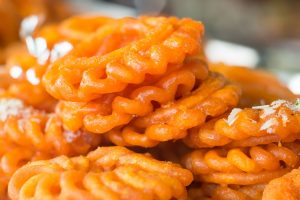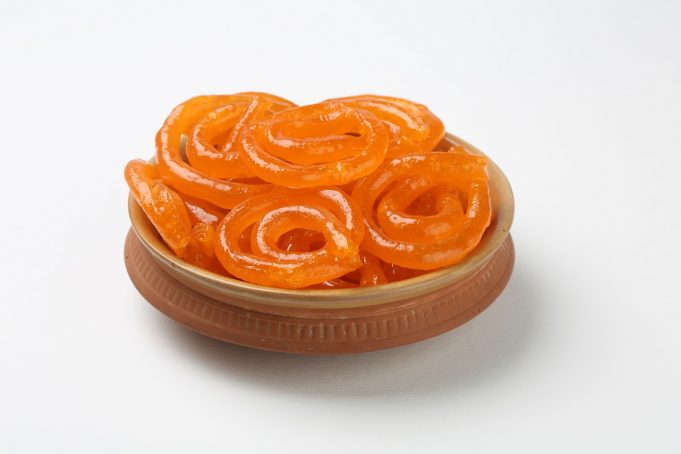Jalebi or Jangiri
A favorite sweet of India, it has two avatars—Jalebi in the north and Jangiri in the south!
The stacked up towers of this orange-hued sweet seen in the streets of Indian cities and towns, attracts gourmand consumer from morning till late in the night. The jalebi has existed in the Indian subcontinent for the past 500 years or so. It is an Arabian sweet that is made by deep-frying fermented, floury batter in a circular shape with decorative whorls and then soaked in sugar syrup. One of the earliest known references to the sweet appears in a Jain work — ‘Priyamkarnapakatha’ — by Jinasura circa 1450 BCE. This was cited in cookery books including the 17th-century classic, ‘Bhojan-kutuhala’ by Raghunatha. It is served warm or cold.
Recipe
Jalebi
Ingredients
2 cups Flour/maida
1 ½ tablespoons Fine grained semolina or rice flour
¼ teaspoon Baking powder
2 tablespoons Curds (plain yogurt)
1 ¼ cups Warm water
½ teaspoon Saffron threads, dry-roasted, powdered
3 cups Sugar
2 2/3 cups Water
½ teaspoon Cardamom powder
1 ½ tablespoon Kewra or rose water
2 cups Ghee or vegetable oil for frying
Method
- Mix the flour, semolina or rice flour, baking powder, curd and ¾ cup of the water in a bowl. Thoroughly beat the ingredients into a batter with a whisk.
- Add remaining water and 1/8 teaspoon of saffron powder and whisk until smooth.
- Set aside for about two hours to ferment. Whisk thoroughly before use.
- Prepare string syrup by dissolving sugar in the water. Add saffron and cardamom powder just before switching off the flame.
- Make an eyehole in a thin muslin cloth bag.
- Heat oil in a wok or deep saucepan.
- Pour the batter into the cloth bag and let it flow in a steady stream into the hot oil. Make a couple of circles first and then cover them up with overlapping whorls. Make four or five in batches. Deep fry until golden and crisp all over but not brown.
- Remove from the wok and drain on kitchen paper.
- Immerse and leave the jalebis in the sugar syrup for at least 4-5 minutes so that they soak the syrup.
- Drain and serve hot by heating them up in the microwave or on a griddle. It is served with curds/yoghurt or milk.
 Jaangiri or Emarti
Jaangiri or Emarti
This is the south Indian variant of the jalebi. This sweetmeat was introduced during the Mughal rule. So it is possible that the word comes from Jahangir!!
It is made with a special variety of urad dal called jalebi paruppu (dal).
Ingredients
¼ kilo Urad dal -whole, skinned
1 tablespoon Rice flour
2 to 3 drops Food Color (saffron)
1 cup Ghee/Oil – to fry
2 cups Sugar
Few drops Rose essence
1 teaspoon Cardamom powder
For garnishing Sliced Almonds/Pistachios (optional)
Method
Sugar syrup
- Dissolve and heat sugar and water in a pan.
- Boil the syrup till it reaches one-string consistency.
- Add cardamom powder, saffron and rose essence.
Jangiri
- Soak whole urad dal in water for 4 hours.
- Drain the water and blend urad dal into a fine batter.
- Add the rice flour and food color and pulse till it is completely integrated.
- To check the consistency of the jangiri batter, put a drop in water. It should float.
- Pour the batter into a icing bag or a piece of cloth with a tiny buttonhole stitched into it. You can use a Ziploc bag with a hole pierced in one corner.
- Heat oil/ghee that comes up to about an inch in a wok or flat saucepan.
- Press the jangiri batter and form two circles. Then form a lacy whorl in a geometrical pattern over the circles and deep fry it till crisp.
- Dip the fried jalebis in the sugar syrup until it expands in size and soaks up the sugar syrup. Serve hot or cold.
















































